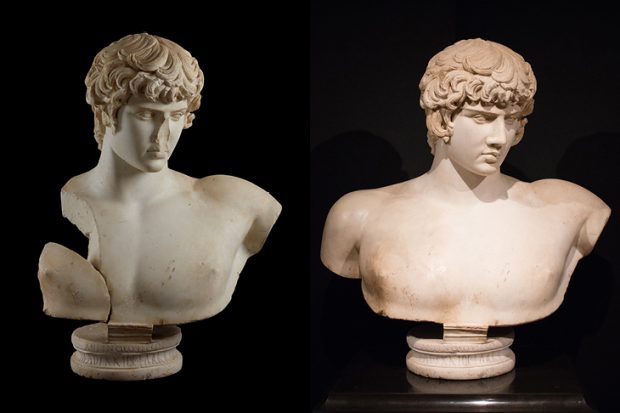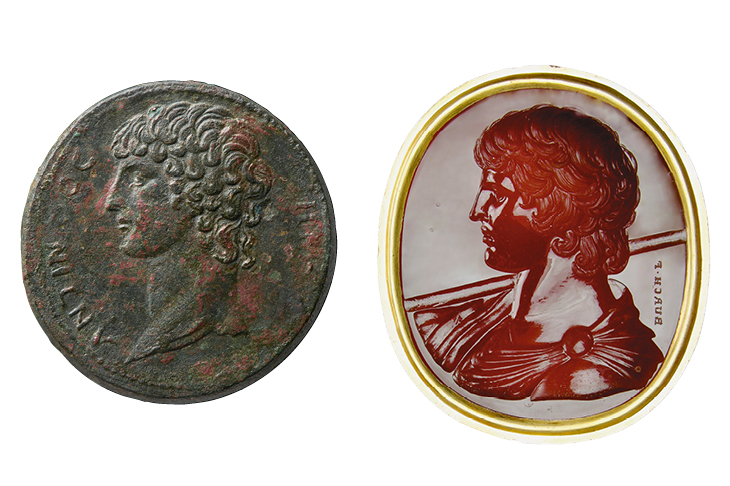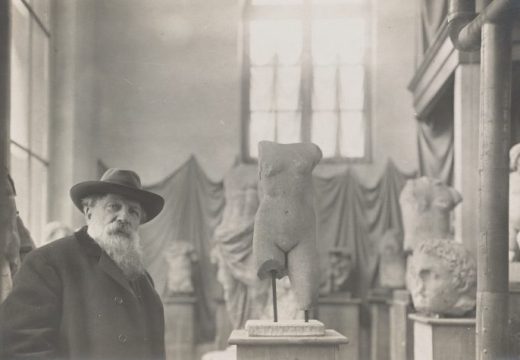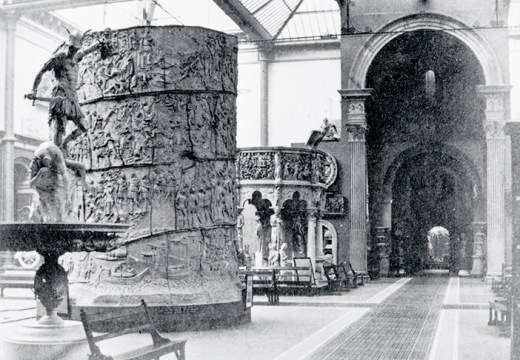‘Ah! This is the inscrutable Bithynian!’ So Tennyson exclaimed when he caught sight of a bust of Antinous while strolling through the British Museum with a young Edmund Gosse, who recorded the episode in Portraits and Sketches (1912). Staring into the eyes of the boy-favourite of Emperor Hadrian, the poet said, ‘If we knew what he knew, we should understand the ancient world.’ Among the 88 sculptures of Antinous that survive from the second century AD – as many as remain of imperial wives and princesses of the time – and the countless modern imitations, the youth emerges as modest yet sensual, godlike yet distinctly fleshly. The inscrutable Bithynian, indeed.
Walking through ‘Antinous: Boy Made God’, a small but substantial cross-section of this tradition currently on display at the Ashmolean, one could be excused for confusing one of the 20 representations of the boy with any handsome Greek athlete or god. As the show’s subtitle suggests, the confusion is telling, since after his mysterious death in the river Nile in 130, at the age of about 19, Antinous was honoured as a hero and then worshipped as a god in some parts of the Roman world until as late as the fifth century in a cult that, to some nervous early Christians (such as Origen of Alexandria), rivalled the nascent cult of Christ. But there’s something distinct about the Antinous ‘type’, the official portrait commissioned by Hadrian after his favourite’s death – something that, once the memory of the homosexual relationship between Antinous and Hadrian faded, drove Renaissance collectors crazy, made Grand Tourists open their pocketbooks, and inspired Winckelmann to dub a portrait of Antinous ‘the glory and crown of the art of the age, as well as any other’.

(Left) Bust of Antinous, discovered in Balanea, Syria, in 1879, before it was restored. (Right) The bust restored.
The centrepiece of the show is the Syrian bust of Antinous (c. 130–138), one of the best surviving examples of the type and the only one bearing an original identifying inscription. Slightly greater than life-sized, the boy (technically not yet a man – a distinction, as the catalogue notes, having to do with the absence of pubic hair) modestly averts his gaze. With his long, straight nose, gently touching lips, and elegant chin, he looks like Hermes, or Apollo, or a young Dionysus, and indeed was portrayed as all three in various sculptures—what R.R.R. Smith in the catalogue calls ‘equivocations’ of the type. Standing close to this bust, which is mounted about eye-level, it is not hard to imagine, as Oscar Wilde put it in his poem ‘The Sphinx’, the ‘ivory body of that rare young slave with / his pomegranate mouth’.
Antinous is always on the verge of unrecognisability, hovering between equivocations, between particular and idealised forms. The object of Winckelmann’s hyperbole – the so-called Albani Antinous – is the most idealised of all, and doubly idealised in the ghostly white resin cast displayed in the Ashmolean show. It shows the boy in profile, wearing a laurel and grasping another in his left hand; his right emerges from the relief, loosely open, as if holding the reins of a chariot. Winckelmann fantasised that he was driving out of this world to his apotheosis – an allegory of the power of art to elevate the human to the divine.

Cast of a relief depicting Antinous at the Villa Albani, Tivoli. Ashmolean Oxford
Yet even from the small collection assembled at the Ashmolean – a rare and satisfying opportunity to study the representation of a single figure in depth – one develops a strong sense of Antinous’s face, his neck, and, particularly, his hair. All versions, regardless of size or costume, share the same rustic, characteristically ‘Eastern’ mane. This unusual coiffure is a key criterion used to identify his image on ancient coins, and was faithfully imitated in the Renaissance, notably by Giovanni da Cavino, who recreated Corinthian Antinous coins in the 16th century, two of which are on display. Even in a massive resin replica of a statue at Hadrian’s villa at Tivoli, Antinous, clothed in traditional Egyptian garb and posed with one foot forward like a Pharoah, retains his particular boyish charm, distinctly different from a bracingly lifelike marble head of Germanicus, the designated successor to Tiberius, who died in 19 AD and was honoured across the empire much as Antinous was a century later. (The bust of Germanicus on display and another of Hadrian feel like a pair of interlopers in a room dominated by a single face.) Part of what it meant to be made a god, it seems, was to be able to take on any form, chameleon-like, while preserving an identity that transcends style, art form, or – as the exhibit, which is largely composed of casts shows – material.

(Left) Antinous coin from Smyrna (AD 134–35); (right) Antinous Marlborough gem (1760–70), Edward Burch; Ashmolean Museum, Oxford (both)
‘Antinous: Boy Made God’ ends, in chronological terms, in the 18th century. The show seems to invite us to look with a museum-going gaze, presenting us with a rich visual tradition. Twenty Antinouses look at us like so many butterflies, encased in glass, abstracted from the social world in which they were produced. In doing so the show sidesteps an aspect of these and other classical sculptures that, in the 21st century, we can’t help but confront: the erotic objectification of a boy. It’s an uncomfortable question. When looking at Antinous’s naked body, and over at the bust of Hadrian (gazing at his favourite from across the room), we simply must consider the implications of art that memorialises, and allows us in some way to participate in, a sexual relationship between the world’s most powerful man and a boy (who was in some traditions a slave). This domination of the powerless by the powerful, of beardless Antinous by bearded Hadrian, has given many a certain frisson; now, it provokes a certain disgust.
But on this question – and on the (homo)erotics of classical art more generally – the wall texts and catalogue remain silent, a legacy, perhaps, of the archaeological approach to ancient art that foregrounds issues of geographical diffusion and authentication rather than matters of interpretation and reception. If we pick up where ‘Antinous: Boy Made God’ leaves off and turn to the moderns – and other art forms – we get a much fuller picture of the Antinous tradition: we read Wilde’s sensuous verses, Fernando Pessoa’s sexually explicit elegy, Marguerite Yourcenar’s novel Memoirs of Hadrian – in which a middle-aged emperor recalls being rejuvenated by his love for Antinous, and even Rufus Wainwright’s new opera Hadrian in which the Emperor has sex with his boy lover on stage. If ancient sculptors and their early modern imitators transformed Antinous from boy to god, these latter-day artists make him a boy once more and urge us to see these perfect white statues as monuments to something altogether more human, more worldly – and more sinister – than ‘the glory and crown of the art of the age’.

Installation view of a cast of the Townley Antinous, cast of a portrait bust of Hadrian and the Elgin Germanicus, at the Ashmolean Museum, Oxford in 2018.
‘Antinous: Boy Made God’ is at the Ashmolean Museum, Oxford until 24 February.
Unlimited access from just $16 every 3 months
Subscribe to get unlimited and exclusive access to the top art stories, interviews and exhibition reviews.














![Masterpiece [Re]discovery 2022. Photo: Ben Fisher Photography, courtesy of Masterpiece London](http://www.apollo-magazine.com/wp-content/uploads/2022/07/MPL2022_4263.jpg)
Has the Fitzwilliam lost the hang of things?